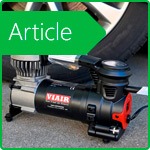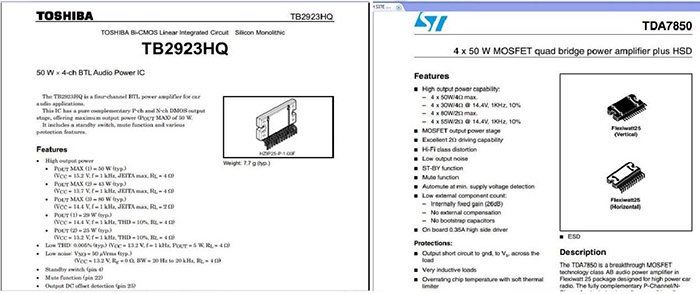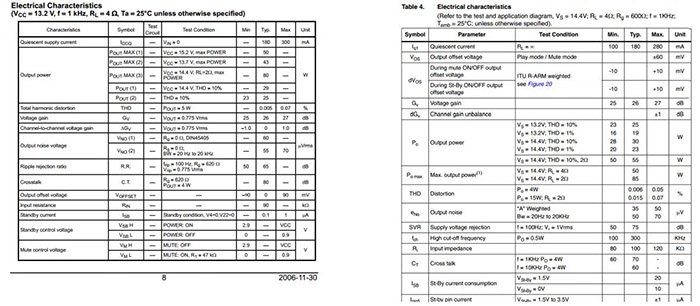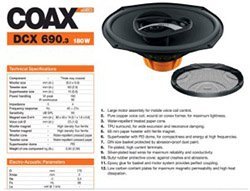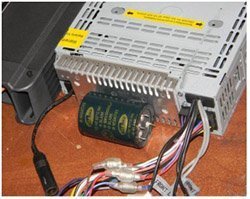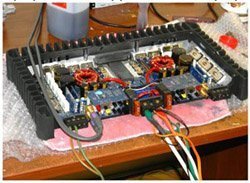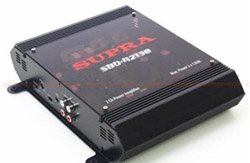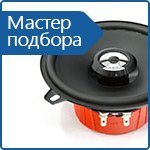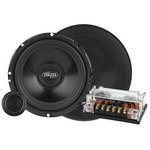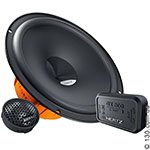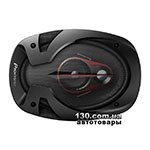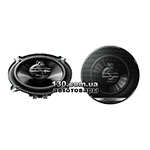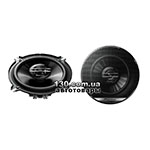Select audio components. Tips engineer
In this article I will try to explain in accessible language about those errors in the choice of equipment that almost all novice users admit.
Misconception 1. Power car radio
Everyone has seen the inscription on the packaging of any, even the cheapest radio tape recorder: MosFet 4 × 50. What do these numbers really mean? Here are screenshots from manufacturers' specifications of the two most demanded integrated amplifier developers for car receivers-Toshiba & amp; SGS Thomson.
At first glance, everything seems to be correct-4 channels of 50 W each. But look closely, under what conditions is this achieved? The maximum power value is obtained at 15.2 V power, and nothing is written about the distortions, since they exceed all imaginable limits! Is it possible in a car that voltage? The same happens with a load of 2 Ohms! It turns out that if you add up the sum of the power of all channels, it turns out 200 W at 4 Ohms and 320 W at 2 Ohms! But the power fuse is designed for 15A, i.e. for consumption of 200 W with power 13.7 volts. And the efficiency of the amplifier is still the same 50%. Where do the missing watts come from?
In fact, these measurements are carried out only on one channel, and then we add the rest in our mind. Has anyone seen the size of the radiator radio? This is a thin strip, usually 3 mm thick, bolted around the perimeter of the end (rear wall) of the radio. Well, is this a heat sink for a 200 W amp? Of course not! And how much then? The following screens show this:
“Honest power”, in which music is still perceived qualitatively, does not exceed 15-19 W. All that is louder is a vinaigrette from a set of sounds when the distortion exceeds the level of the useful signal. In addition, you should not forget that this power is achieved only with a “cold” radiator-at 25 ° C. But after a few minutes the temperature will rise to 55-60 ° C and the power will be 2/3 of the initial. Alas, but this is a feature of the work of any semiconductor, and you need to accept it. If there is forced airflow from the radiator (usually in 2-din units and in expensive single-din ones), then you can “squeeze” the denomination. In other cases, the continuous power will not exceed 15 W per channel, i.e. 60 W in the amount. And on a muffled engine at a voltage of 12.6 Volts, “will remain” only 45-50 W ... But even that’s not all ... Quality at the Hi-Fi level (distortion less than 0.007%) is obtained with a power of no more than 7 W per channel. Looking ahead, I’ll say-for those who plan to use an external amplifier connected via a high-level input (to the wires going to the speakers from the radio), you should not expect a chic quality, even when using very expensive amplifiers. As can be seen from the tables, the measurements were carried out on a sinusoidal signal with a frequency of 1 kHz, i.e. at mid frequencies. Accordingly, in the lower register these indicators will be slightly worse. And if you add here the level of self-noise of this amplifier, it becomes clear why this method is not the most successful.
Misconception 2. Power of complete speakers
From the history of the development of audio technology, we remember that the higher the class of equipment, the wider the frequency range of the amplification path. Today there is practically no such separation, well, if you take the automotive sector. And the declared 20Hz-20 kHz can already be found both in cheap amplifiers and in radio tape recorders of the lower price category. And what about the speakers? Here, everything is not so rosy ... In most cases, the lower playback range is about 45-48 Hz.
Now let's simulate the situation: we have the following autocolumns Hertz DCX690.3 in the front doors. The developer claims up to 90 W of nominal power, 4x50 W is written on the radio tape recorder, it seems that the speakers have a “margin”, they have a very high sensitivity of 93 dB, but at the maximum volume, the speakers wheeze. Some "gurus" declare-these are weak dynamics, buy by more powerful. Others say, on the contrary, it is a weak radio tape recorder, buy an amplifier and do not worry. But after all, Italians are some of the best audio technology developers in the world, and the tape recorders are “adapted” to any speakers. What is the problem? And, it turns out, you just need to understand the parameters of the speaker and adjust the frequency range of the radio for it. At the end of the table one of the most important speaker parameters is visible-Xmax. Here the permissible deviation of the moving system upward + downward relative to the average position, at which the quality and power parameters will be maintained, is indicated. In this model, only 2mm.
But why the speaker wheezes? Yes, because when the amplitude of the stroke is exceeded, the electromechanical characteristics of the speaker also change. And if, with a power of 5-7 W, this speaker will perfectly crush with bass, then already at a power above 10 W, an overload in the LF region will begin for it. Fans of bass below 50 Hz, these speakers do not fit and just need to put an external subwoofer. And if not, limit the level of low frequencies below 50 Hz at -4 dB or even lower, or shift the lower range to 100-120 Hz. Only if this condition is observed can the maximum sound power on the radio tape recorder and the maximum quality be achieved on the speaker. It's simple!
Well, if you want both loud and bass for more, then you really need other speakers, but their choice does not depend on the permissible power, but is determined by this value of Xmax. The higher it is, the more permissible level of bass you can "squeeze" out of the speaker. So carefully read the specifications, it is better if there is such infa on the developer’s site and do not be afraid to ask a specialist for advice. After all, you risk not only your money spent, but also the probability of burning the speakers and become disillusioned with the products of those who know a lot about auto sound! And remember: even a radio tape recorder requires powerful power wires of at least 2.5 mm², you shouldn’t save with acoustic too, I would advise you to install a capacitor near the input connector, you can take the usual lead-out electrolyte 100.000 microfarads x 16 V. You will hear the difference!
A few words about the capacitor itself. Its task is to maintain the supply current near the input connector, since any wires have resistance, and this causes a voltage drop. The device has its own capacitor, but its capacity is small, and it is needed as a filter for impulse noise. But if its capacity is large, then with peak current consumption by the power amplifier, it more smoothly holds the voltage, thereby reducing dynamic distortions (I said this at the beginning of the first section-dependence of the output power of the amplifier on the supply voltage level). This option is cheaper than automotive capacitors, and for the radio itself it is almost enough (the recharge current is about 10A). It takes up little space, and you can fix it directly on the connector near the radiator.
Misconception 3. Choosing a power amplifier
To the question-why is it needed at all, few can give an adequate answer. After all, this is not just a banal amplifier, but a complex set of adjustments of levels, phases and frequencies, ensuring the highest possible amplification of the original signal and the correct distribution of sound pressure in the cabin. In the previous article I described why the concept of power to the speakers is not correct, namely, sound pressure. It determines the volume that we hear from the input from the power amplifier. And how to determine the level of sound pressure? Well, here is an example of two speakers of the same series, but of different sizes (mini and maxi):
As you can see, their sensitivity is almost equal to 92/93 dB. Now tell me which one will play louder? Obviously, the second. And not in one decibel difference, but in the size of the area of diffusers. And the bigger it is, the louder the speaker will sound, with equal input power. Accordingly, if there was a coaxial with a diameter of 25 cm (10 "), he would be able to create a sound stage of sufficient volume not to use a subwoofer. But! Where to install it, if the plane of the door card does not have enough space for such a device? an external amplifier comes to the rescue.
In the simplest case, we buy expensive and powerful coaxials, we mount a 4-channel amplifier and enjoy more loud and sufficiently high-quality music in the car. Another thing, if you need to build a quality system with high power and at least high quality. In this case, just need a component solution acoustics. By decomposing the frequency range into 2, and preferably into 3 bands, and even a sub into the bargain, you can achieve excellent results. But how to choose the "right amplifier"? Let's see. So, first we build the project of our system in our mind, having previously studied the budget and the capabilities of the car. Suppose you chose version 2.1 (front speakers to the front + sub on the rear to the bridge, the rear speakers will continue to work from the radio as a sub-sound). Usually for such purposes choose 4 kanalich, which copes with this task. However, the correct selection of the amplifier and acoustics is not simple, and on the shelves of stores and on the Internet is full of the most bizarre models that, however, do not always meet our expectations.
How to pick up the amplifier? Having a scheme, I know about them even what sellers and managers do not know, so it is easier for me. That is why I want to help you learn how to choose them. So where to start? The main thing is to try in the press (paper or electronic) to find an advertising article about this device, if possible, with a photo. They can see approximately what is inside the product.
The main factors are the transformer diameter of the voltage converter, the size and total capacity of the secondary electrolytes, the type of output transistors, the size and total weight of the amplifier, the total current of the fuses. The more visually it is, the more likely it is that the declared parameters are close to the actual ones. Here is an example of one of these options for a high-quality audio system: This is the Focal FPS-4160 amplifier, the flagship model in this series. It has a massive molded case, large capacitors (it is possible to double them by connecting external ones with special connectors), 2 powerful transformers, one for each pair of channels, powerful MosFet transistors, 2x40A fuses, and also an integrated cooler 80x80x25 mm ( photo not shown). Such a device will easily rock the audio system and create a powerful sound in your car. This model was developed as an amplifier capable of participating in competitions on auto sound, and a multifunctional crossover will allow you to properly adjust any speakers to the format of Hi-Fi class.
Another thing is if you were offered a “economy option,” some kind of Chinese amplifier that is very compact and even with the transparent case of their acrylic. What can you get from it, except for a bummer ... The first thing you notice in the sound is sluggishness and low power, with a creaking at the maximum level. In addition, the subwoofer does not swing such an amplifier, no matter what measures you take. Even its refinement, as I practice it, will not allow it to be fully realized, since it will be necessary to “fence” external coolers for both sides. In a word tin. Of course, hardly anyone will go to such extremes of choice, but if there is a product, there will definitely be a buyer. The main thing is not to throw money and effort into the wind. There are always win-win options, they go in the category "Bestseller". But even in this case, it is necessary to carefully read the product specifications in order to correctly predict the outcome of a future installation and avoid alterations in the process of wiretapping and tuning.
Here are some of the details found in this product category. You can condemn or extol those or other manufacturers of audio equipment, but the choice is always the client. And my task is to suggest what is often silent when selling goods. And if there is a person to whom this will help, it means that I will continue to do this further, improving my experience and skill. And I wish you to always make the right choice and never regret the time spent on studying the material. No wonder they say: Knowledge is Power! Sound amplifier can be bought in Kharkov, Kiev, Odessa with delivery in Ukraine at 130.com.ua.
Materials on the topic
Car acoustics: Best Sellers

Stay tuned for updates!
Subscribe to our Telegram channel and be the first to receive useful materials.
Subscribe













